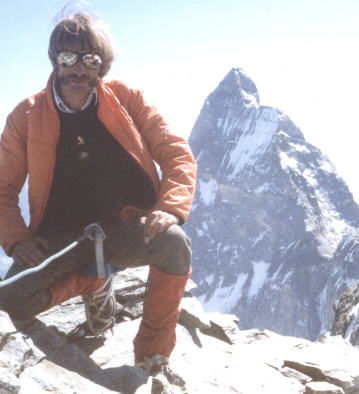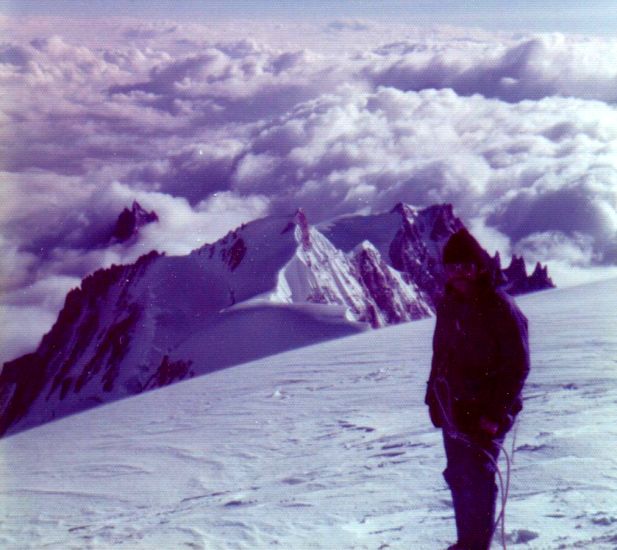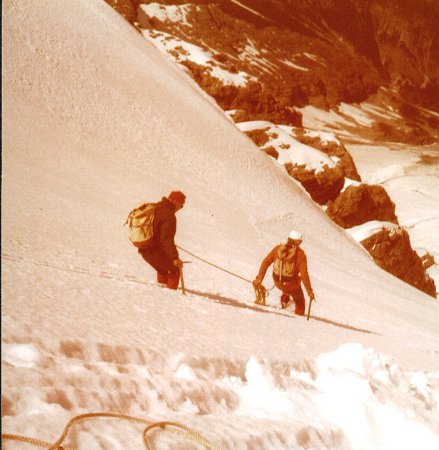 |
 |
Winter mountaineering experience in the Scottish Highlands provides an excellent foundation for first forays into the European Alps. Although new horizons with greater challenges are opened, clothing and essential equipment - the mandatory ice-axe and crampons - remain the same. While some major summits, such as the Gross Glockner in the Austrian Tyrol and the Monch in the Bernese Oberland, are feasible in a single day most alpine climbs require at least two days with an initial half-day ascent to a hut at the starting point of one's chosen route. In many cases cable cars or rack-and-pinion railways can be used to avoid such arduous uphill slogs ( and the agonies and damage to one's feet and knees of the corresponding descent ) carrying a heavy pack of climbing and overnight sleeping gear. Otherwise, ski-sticks are highly recommended to relieve the strains and stresses imposed. Hut to hut tours enable high-level, multi-day, mountain travels without recourse to descents to the valley floor.
 Normal Route on Mont Blanc |
In huts serving easy, F ( Facile ) grade routes, such as the Refuge du Gouter on the normal route to Mont Blanc, overcrowding can be a major problem, especially at weekends, with people sleeping two per bunk, on table-tops and on the floor. Membership of an alpine club such as the OAV ( Austrian Alpine Club ) or SAC ( Swiss Alpine Club ) ensures you are not refused entry and reduces the hut charges levied. Insurance cover is also enabled ( as with the BMC, the British Mountaineering Club ) which can otherwise prove difficult and expensive to obtain - unlike Scotland, rescue services in the Alps must be paid for.
Numbers usually drop off dramatically for huts serving only harder, PD ( Peu Difficile ) routes and above - the ever busy Hornli Hut on the Matterhorn is an exception.
 The Matterhorn ( Il Cervino ) from Theodul Hut
|
|
Huts on well-frequented routes have resident wardens and supporting staff to supervise visitors and prepare meals but those on less-frequented routes may be unmanned as I was surprised to discover on the Weisshorn and at the Rottal Hut on the SW ridge of the Jungfrau - we were the only occupiers.
As well as the danger from avalanches the additional hazards involved in alpine mountaineering are glaciers, ice-falls and crevasses. Even on well-frequented climbs someone has to be the unfortunate who breaks through a previously safe snow-bridge and a rope of three is the recommended minimum. Nevertheless guided parties on the popular, easier routes are commonly tailed by "solo" climbers who hitch lifts from roped groups to cross suspect slopes.
The increased altitude also poses a problem and acclimatization is advisable on the many 3000 metre peaks before tackling the higher 4000 metre summits. Unlike the Himalaya, fatalities from AMS ( Acute Mountain Sickness ) are rare in the Alps with symptons usually restricted to lethargy, headaches and nausea. Lightning storms are another, literally hair-raising hazard when it is advisable to dispose of all one's iron-mongery.
 |
|
Collecting the 80 "four-thousanders" of the European Alps is the continental equivalent of Scottish Munro bagging. Although some pose no technical difficulties others such as the Schreckhorn ( "Terror Peak " ) present a much harder challenge than the Inaccessible Pinnacle - the stumbling block for many would-be Munroists.
From a hut the customary "alpine-start" time in the early hours of the morning is dependant on the vertical distance to reach the target summit and should enable it to be reached before noon with rapid progress possible on firm snow before it softens in the heat of the sun. Scottish mountaineers in the Alps have however gained a reputation for being last out of the huts in the morning and returning in the dark, long after everybody else, by the light of matches. Laggards leaving the Refuge du Gouter can however admire the long line of head torches illuminating the upper slopes of Mont Blanc like rows of street lamps. On a good day some two hundred climbers attain the 4800 metre summit - second highest in the continent of Europe to the 5600 metre Mt.Elbrus in the Caucasus ( one of the "Seven Summits" - the highest peaks of the seven continents ).
 Summit view from Mont Blanc |
Locations of huts and their access routes are given on continental climbing maps as are the normal routes to summits. Maps may also specify the different symbols painted on trees or rocks to signpost routes. For the less frequented and more difficult routes a detailed description from a good guide book is helpful but all alpine climbs depend on prevailing snow conditions which vary both from season to season and with time of season - late in the season crevasses are more exposed while each year there is effectively a first ascent. On one tour I was lucky enough to be on the first ascent of the season of the Ortler - much to the chagrin of local climbers who had been waiting for it to come into condition but arrived a day too late.
 Descending the Ortler |
All my alpine climbing tours have however been confined to the summer months - winter mountaineering in the Alps with its extreme conditions is not for me - a single night spent in a snow hole on the Jungfrau one July was more than sufficiently cold to endure.
(The Commentator, The ( Glasgow ) HERALD, Saturday 19th June 1999 )